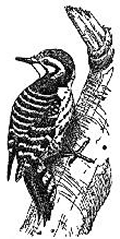Mystery Signals of the Short Wave
Dedicated to the more unusual, strange, bizarre and apparently meaningless signals on the short wave bands !
From the Archives
Russian Woodpecker | Yosemite Sam |
Site Information
What's New | About Me | Email |
From the Archives
"The Russian Woodpecker"
A collection of Articles on the powerful Russian signal that swamped the shortwaves in the 1970s - 1980s

This signal, probably the most powerful signal ever to be heard on the shortwave bands consisted of complex pulsing signals which continued for hours on end.
Recognisable by its signal strength, the unmistakable "rat-tat-tat" sound of 10 pulses per second caused it to be nicknamed "The Woodpecker".
Although the frequency use varied, no part of the shortwave spectrum was free from this incredibly strong signal, much of which was rendered unusable for long periods of time. The use of Direction Finding equipment traced the signals to the area of Gomel, Russia.
Severe interference was caused to both professional and amateur users of the bands, and official complaints were lodged by many countries.
Speculation about the purpose of the signals ranged from submarine communication to weather control, even mind control and mood changing! However, the general consensus finally arrived at a form of Over-The Horizon radar system - something the West was experimenting with too!
Having caused havoc for so long, the signals finally ceased.
Interest in "The Woodpecker" had caused worldwide interest.
"The Daily Mail" Article
This article, appeared on the front page of the English national newspaper "The Daily Mail" in December 1978.
"Wireless World" Article
This much more detailed technical article appeared in the UK publication "Wireless World" in February 1977.
Peter Martinez' letter and plot
Peter Martinez wrote to the "Wireless World" in April 1982. Using a laboratory spectrum analyser to examine the signals, he was able to show that there were four Woodpecker transmitters, each encoding their transmissions with a different 31 bit binary code - which enabled received echoes to be separated and used to provide a three-dimensional position of any target.
"Monitoring Times" Article
Another article from David L Wilson, giving a detailed analysis of the operation and signals from "The Woodpecker" appeared in the American magazine "Monitoring Times" in the Summer of 1985.
Official Practice Target
There was even a "Russian Woodpecker Hunting Club" formed by radio amateurs. They produced this "Official Practice Target" to encourage protest to the Russian authorities, and took direct action against "The Woodpecker" signal when it appeared in the amateur Bands. (Click on the "Miami Herald" article below to see how this was achieved).
"Miami Herald" Article
How the club attempted to combat the unwanted interference in the amateur bands is explained in this article published on writer Dave Finley's Website, which first appeared in USA's "Miami Herald" in July 1982.
Steel Yard OTH. For more information about the development of the Soviet Union's OTH radar systems, including details of "The Steel Yard" OTH ("The Woodpecker").